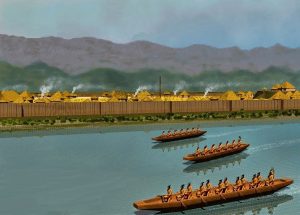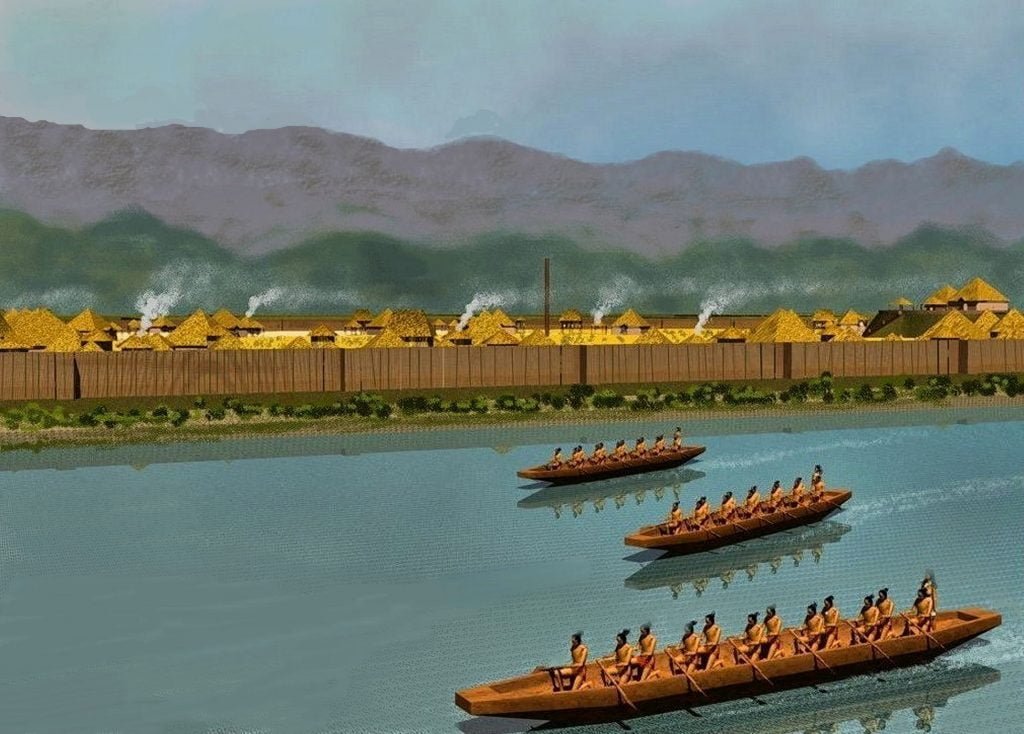The Native American town of Chiaha was visited by the Hernando de Soto Expedition in July of 1541. It was visited at least twice by the Juan Pardo Expedition of 1567. Both expeditions were authorized by the Spanish Crown, but the two expeditions did not take the same routes. Chiaha is one of only three towns, along with Cofitachiqui and Tasqui that are mentioned by both the chronicles of de Soto’s journey and Pardo’s chronicle by Juan de la Bandera. Chiaha is the only town in the Southern Highlands that is mentioned by all of these chronicles.
Chiaha is unique also in that it was one of the very few towns mentioned by 16th century Spanish explorers that was also occupied when Georgia was colonized 1732. However, when denoted on 18th century English and French maps, it was located in southwestern Georgia. The occupants of Chiaha had apparently moved to the new location to join with the Creek Confederacy in the late 1600s or early 1700s.
The Gentleman of Elvas described de Soto’s visit to Chiaha in Chapter 15. It reads:
On July 5, 1541, the governor entered Chiaha. The cacique (leader) moved out of his houses in which he was lodging and welcomed him very hospitably, with the following words, “Powerful and excellent lord. I consider myself so fortunate in that your Lordship is pleased to use my services that no greater happiness come to me, nor any that I could esteem as much. Your Lordship ordered me from Guaxulle to have maize for you in this town for two months. I have here for you 20 barbacoas (barns) full of maize, and the best that can be found in all the land.”
“The town was isolated between two arms of a river and settled near one of them. At a distance of two crossbow bolt shots above the town, the river divided into those two arms, which were reunited a league below. They (the river channels) were of great width and both were fordable.”
“In that town there was an abundance of butter in gourds, in melted form like olive oil. They said it was bear’s grease. There was also found considerable walnut oil (actually hickory nut oil) which like the butter was clean and of a good taste, and a pot of bee’s honey; which before or after was not seen in all the land – neither honey nor bees.”

The bear’s grease was use for frying flat cakes on a griddle. The hickory nut oil was used by the Creek Indians and their ancestors to deep-fry battered poultry and fish. These dishes were the origin of Southern Style Cooking!
The end of the last paragraph above is one of the most important in all of the de Soto chronicles. Its significance has been lost for 450 years, and even was missed by the joint study of the de Soto Expedition by the Universities of Alabama, Georgia and North Carolina in the 1980s and 1990s. The domestic honey bee raised in North America today was imported from Europe. The Mayas were the only indigenous peoples in the Western Hemisphere, who had developed an indigenous stingless bee into a honey producer. That evidence along with the Maya name of Chiaha (see below) is almost certain proof of a Maya immigration into the Southeastern United States.
Juan de la Bandera accompanied Captain Juan Pardo in his visits to Chiaha. Unlike the de Soto chronicles, his is an eyewitness account:
“Captain Juan Pardo, continuing his journey on October 7, 1567, arrived at a place which is called Chiaha. In order to enter it, the captain with his company crossed three copious rivers and entered in the place. It is an excellent, strong site because it is an island surrounded by copious rivers.”
“The Indian through the interpreter let it be understood that the journey (to Kusa) would be much better going by a river which passed by Olameco, which by another name is called Chiaha, rather than going by the road directly to Coça (Kusa.) As soon as he arrived, he laid out a fort which it was agreed should be built in Olamico. Thus, it was begun to be built and then after four days, it was finished. The captain left in the fort Corporal Marcos Jimenez with 25 men, soldiers of the company in order that they should be there and guard the fort.”
Pardo had been warned that the armies of Kusa, Casqui (Koasati) and Uchi (Yuchee) had planned to ambush him on the road to Kusa. The text also stated that many Spaniards had been killed on this route before. This statement suggests that there were other Spanish explorations of the Southern Highlands after the de Soto Expedition that have been forgotten by history. Apparently, Pardo never saw Jimenez company again. It was presumed by the governor in Santa Elena (Parris Island, SC) that they had been massacred, but they may have “gone native” in order to mine the silver ore found at the higher elevations of rugged mountains near Chiaha.
None of the Spanish chronicles described the architecture of Chiaha or its precise location in relation to other Native American towns. It is called an u’lamako (olameco) which means a provincial capital, which probably means that it contained mounds. De Soto’s chroniclers stated that the island was about 2.6 miles (4.2 km) long. A Spanish legua (league) equaled about 2.6 miles. The Gentleman of Elvas stated that Chiaha Island was surrounded by two broad, shallow channels of a river. The Pardo Chronicle stated that the expedition crossed three wide rivers in order to reach the river where Chiaha was located. That river apparently flowed into the Tennessee River, which was an alternative route for reaching Kusa.
Meaning of Chiaha
The word “Chiaha” has no meaning in contemporary Muskogean languages or Cherokee, other than being a proper noun in the Creek languages. The inormation about the bees and honey opens up the strong possibility of the name being Maya. In fact, Chiaja, the Spanish spelling of the word, is common place name in southern Mexico that is now used for road names like North Americans use “riverside.” The original Itza Maya word is chi’a-ha, which means “beside the river.” That would be an appropriate name for a province with so many mountain rivers. The name of the Hitchiti-speaking Creeks for themselves is Itsa-ti, pronounced It-jsha-tee. It means “Itza People.”
Alternative locations for Chiaha
Until a Native American town site can be found on an island in the Southern Highlands that was occupied in 1541 AD and contains 16th century Spanish artifacts, no certain location for Chiaha can be confirmed. Several locations have been proposed by scholars in the past. These include:
The 1718 Map of the Province of Louisiana by Guillaume DeLisle placed Chiaha at the headwaters of the Savannah River where the Tallulah, Tugaloo and Keowee Rivers join. There was a very large Muskogean town located on a long island in the Tugaloo River. However, the Savannah River flows to the Atlantic Ocean, which is the opposite direction of Kusa’s probable location in northwestern Georgia. There are no high mountains between Tugaloo Island and the Piedmont. There are no known silver deposits in that region.
The 1939 De Soto Commission placed Chiaha on the site of Rome, GA, where the Etowah River joins the Oostanaula River to form the Coosa River. There was a large Muskogean town at that location, but it is not an island. There is no geological evidence of Downtown Rome ever being an island in the past 500 years. There are no known silver deposits or high mountains near Rome.
The 1980’s De Soto University Consortium placed Chiaha on a long island in the French Broad River upstream from Newport, TN. The island does contain some mounds, but the site has never been studied by archeologists. Pardo crossed three rivers in the vicinity of the one on which Chiaha was sited. There are no other rivers in the vicinity of the French Broad River near Newport. There are no known silver deposits near the French Broad River Valley.
The Bryson City, NC Area contains one of the largest expanses of fertile bottomland in western North Carolina. Here the Tuckaseegee, Oconaluftee and Nantahala Rivers join the Little Tennessee River. There are several Native American town sites with mounds in the bottomlands, but none have been studied thoroughly by archaeologists. There are silver ore deposits in the higher elevations of the nearby Snowbird Mountains. There are several (current and recent) long islands in these rivers that come together. The Little Tennessee River flows to the Tennessee River, which then flows into the former province of Kusa. There is an ancient Native American trade path that ran from Bryson City’s location through the Nantahala Gorge into the Andrews Valley, where it crossed the Hiwassee Valley. From there the trade path went to the probable site of Kusa. There are several Native American town sites along this route.
The Bryson City Area matches every characteristic ascribed to the capital of Chiaha and its province. Unfortunately, very little archaeological work has been done in this section of the North Carolina Mountains, so it is impossible to know if the known Native American town sites were occupied in 1541.


